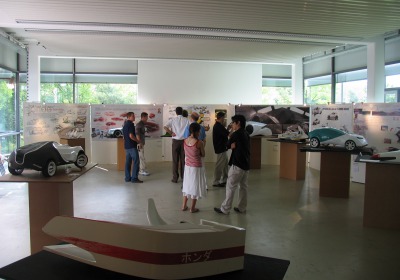College Exhibition: Pforzheim University Summer Degree Show 2006
Fri, 22 Sep 2006Transportation Design students at Germany's Pforzheim University displayed their work in the school's summer degree show held in July, one of two graduation shows per year. The show was held in conjunction with the International Transportation Design Forum 2006, alongside work from six other international design schools.
The exhibition included work from graduating Diploma and Masters students, exterior and interior projects by the 5th and 7th semester students, as well as work from students in the earlier stages of the Diploma and Masters courses.
Projects by students graduating from the four year Diploma course included:
Patrick Faulwetter
Amphibian vehicle for a cruise in 2030
This presentation featured a strong form/graphic language and uniquely detailed illustrations describing a range of vehicles within their architectural environment. The concept was that by 2030 the oceans will have risen and the deserts will have expanded. Subsequently, human settlement will be concentrated more onto the coasts and the water. For this scenario 'Shangri La cruises' develops a 1000 meter long cruise ship as a floating city, creating a habitat for thousands of passengers. A huge architecture composed of two hulls connected with bridge structures creates artificial islands and a lagoon. For this new interpretation of a cruise, the 'Bugatti aerocopter' is working as an air taxi. With the amphibian vehicle 'MEO', 'Volkswagen offshore' is responsible for the individual mobility of the passengers around the ship. The front wheels swing up when in the water, while the rear wheels act as impellers, drawing water through to the rear jet outlets.
Randolph Koerber
InTown
This city car combines architecture and automotive design to link the vehicle to the changing cityscape of Berlin and to fit wirhin the city's infrastructure. Growing volumes of traffic and demand for parking were some of the reasons for its small dimensions. Two themes from modern architecture were applied to the concept. The first - 'facade' - defines the nature of space and boundary from an architectural point of view. The second is the 'outsourcing of technical elements' that may impact the interior passenger compartment space, such as engine, powertrain, luggage area and anything else that is unnecessary for driver control. Thus the car offers space for two adults and a child, with the child sitting in front of the co-driver. The overlapping side windows use surfaces made of electrochromatic glass, allowing the opacity to be changed to screen the occupants from view.The offset shape of the rear side elements visually defines the separation of the cockpit from the body shell and electric skateboard-like powertrain.
City Carver
Ulrich Joven
The vehicle combines the advantages of a tilting three-wheeler with those of a vehicle with variable wheelbase. The tilting mechanics help achieve a very narrow vehicle that can still corner safely at high speed. The vehicle can shorten of lengthen its wheelbase in proportion to its height to optimize its dynamics for the current road condition - a long wheelbase, low centre of gravity and a small cross-section for high speed freeway driving or a short wheelbase and a higher driving position for busy traffic in city streets. A 'parking-mode' enables the driver to park the vehicle in a space-saving way.
By

